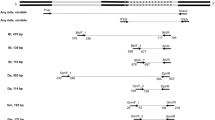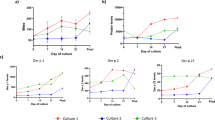Abstract
Dust mites produce bacteriolytic enzymes, one of which belongs to the NlpC/P60 superfamily comprising bacterial and fungal proteins. Whether this enzyme is derived from the mite or from mite-associated microbes is unclear. To this end, the bacteriology of mites per se, and carpet and mattress dust from a group of asthmatic children and their parents was investigated. Dust from parents’ and children’s mattresses yielded significantly more colony forming units compared with dust from their corresponding carpets. Zymography demonstrated some dusts contained bacteriolytic enzymes, and in nine of the twelve dust samples from three of five houses examined, a prominent bacteriolytic band was obtained that corresponded to the mite band, although in one home, other lytic bands were detected. Fifty bacterial isolates were obtained from surface-sterilised, commercially obtained Dermatophagoides pteronyssinus. 16S rRNA, tuf and rpoB gene sequencing of nine Gram-positive isolates identified them as Bacillus cereus, B. licheniformis, Staphylococcus aureus, S. epidermidis, S. capitis and Micrococcus luteus, known human skin commensals. 16S rRNA sequence homologies of four of the nine isolates identified as B. licheniformis formed a distinct phylogenetic cluster. All species secreted lytic enzymes during culture although the lytic profiles obtained differed between the rods and the cocci, and none of the bands detected corresponded to those observed in dust or mites. In conclusion, mites harbour a variety of bacterial species often associated with human skin and house dusts contain bacteriolytic enzymes that may be mite-derived. The identification of a novel cluster of B. licheniformis isolates suggests an ecological adaptation to laboratory-reared D. pteronyssinus. It remains to be determined whether the previously described mite-associated 14 K lytic enzyme is derived from a microbial source.



Similar content being viewed by others
References
Altschul SF, Gish W, Miller W, Myers EW, Lipman DJ (1990) Basic local alignment search tool. J Mol Biol 215:403–410
Arlian LG (1989) Biology, host relations, and epidemiology of Sarcoptes scabiei. Annu Rev Entomol 34:139–161
Barabanova VV, Zheltikova TM (1985) Digestive enzymes of acarids Dermatophagoides pteronyssinus and D. farina (Acariformes: Pyroglyphidae). Doklady Akademii Nauki CCCP 283:225–227
Blackwood KS, Turenne CY, Harmsen D, Kabani AM (2004) Reassessment of sequence-based targets for identification of Bacillus species. J Clin Microbiol 42:1626–1630
Cazemier AE, Hackstein JHP, Op den Camp HJM, Rosenberg J, van der Drift C (1997) Bacteria in the intestinal tract of different species of arthropods. Microb Ecol 33:189–197
Chua KY, Stewart GA, Thomas WR, Simpson RJ, Dilworth RJ, Plozza TM, Turner KJ (1988) Sequence analysis of cDNA coding for a major house dust mite allergen, Der p 1. Homology with cysteine proteases. J Exp Med 167:175–182
Colloff MJ (2009) Dust mites. In: Findlay A (ed) Physiology and internal anatomy. CSIRO Publishing, Collingwood, Victoria, 62 pp
Dahllöf I, Baillie H, Kjelleberg S (2000) rpoB-based microbial community analysis avoids limitations inherent in 16S rRNA gene intraspecies heterogeneity. Appl Environ Microbiol 66:3376–3380
Dawson DJ (1971) Potential pathogens among strains of mycobacteria isolated from house-dusts. Med J Aust 1:679–681
Erban T, Hubert J (2008) Digestive function of lysozyme in synanthropic acaridid mites enables utilization of bacteria as a food source. Exp Appl Acarol 44:199–212
Evans CA, Mattern KL, Hallam SL (1978) Isolation and identification of Peptococcus saccharolyticus from human skin. J Clin Microbiol 7:261–264
Farrior JW, Kloos WE (1976) Sulfur amino acid auxotrophy in Micrococcus species isolated from human skin. Can J Microbiol 22:1680–1690
Fisher WF, Wilson GI (1977) Precipitating antibodies in cattle infested by Psoroptes ovis (Acarina: Psoroptidae). J Med Entomol 14:146–151
Fox GE, Wisotzkey JD, Jurtshuk P Jr (1992) How close is close: 16S rRNA sequence identity may not be sufficient to guarantee species identity. Int J Syst Bacteriol 42:166–170
Ghebremedhin B, Layer F, Konig W, Konig B (2008) Genetic classification and distinguishing of Staphylococcus species based on different partial gap, 16S rRNA, hsp60, rpoB, sodA, and tuf gene sequences. J Clin Microbiol 46:1019–1025
Glass M (1973) Sarcina species on the skin of the human forearm. Trans St Johns Hosp Dermatol Soc 59:56–60
Hay DB, Hart BJ, Pearce RB, Kozakiewicz Z, Douglas AE (1992) How relevant are house dust mite-fungal interactions in laboratory culture to the natural dust system? Exp Appl Acarol 16:37–47
Hill DJ, Thompson PJ, Stewart GA, Carlin JB, Nolan TM, Kemp AS, Hosking CS (1997) The Melbourne house dust mite study: eliminating house dust mites in the domestic environment. J Allergy Clin Immunol 99:323–329
Hogg JC, Lehane MJ (1999) Identification of bacterial species associated with the sheep scab mite (Psoroptes ovis) by using amplified genes coding for 16S rRNA. Appl Environ Microbiol 65:4227–4229
Horak B (1987) Preliminary study on the concentration and species composition of bacteria, fungi and mites in samples of house dust from Silesia (Poland). Allergol Immunopathol (Madr) 15:161–166
Horak B, Dutkiewicz J, Solarz K (1996) Microflora and acarofauna of bed dust from homes in Upper Silesia, Poland. Ann Allergy Asthma Immunol 76:41–50
Hubert J, Kopecký J, Perotti MA, Nesvorná M, Braig HR, Ságová-Marečková M, Macovei L, Zurek L (2012a) Detection and identification of species-specific bacteria associated with synanthropic mites. Microb Ecol 63:919–928
Hubert J, Nesvorna M, Sagova-Mareckova M, Kopecky J (2012b) Shift of bacterial community in synanthropic mite Tyrophagus putrescentiae induced by Fusarium fungal diet. PLoS One 7:e48429
King C, Simpson RJ, Moritz RL, Reed GE, Thompson PJ, Stewart GA (1996) The isolation and characterization of a novel collagenolytic serine protease allergen (Der p 9) from the dust mite Dermatophagoides pteronyssinus. J Allergy Clin Immunol 98:739–747
Kopecky J, Perotti MA, Nesvorna M, Erban T, Hubert J (2013) Cardinium endosymbionts are widespread in synanthropic mite species (Acari: Astigmata). J Invertebr Pathol 112:20–23
Lake FR, Ward LD, Simpson RJ, Thompson PJ, Stewart GA (1991) House dust mite-derived amylase: allergenicity and physicochemical characterization. J Allergy Clin Immunol 87:1035–1042
Lee L, Tin S, Kelley ST (2007) Culture-independent analysis of bacterial diversity in a child-care facility. BMC Microbiol 7:27
Martineau F, Picard FJ, Ke D, Paradis S, Roy PH, Ouellette M, Bergeron MG (2001) Development of a PCR assay for identification of staphylococci at genus and species levels. J Clin Microbiol 39:2541–2547
Mathaba LT, Pope CH, Lenzo J, Hartofillis M, Peake H, Moritz RL, Simpson RJ, Bubert A, Thompson PJ, Stewart GA (2002) Isolation and characterisation of a 13.8-kDa bacteriolytic enzyme from house dust mite extracts: homology with prokaryotic proteins suggests that the enzyme could be bacterially derived. FEMS Immunol Med Microbiol 33:77–88
Mathieson BRF, Lehane MJ (1996) Isolation of the Gram-negative bacterium, Serratia marcescens, from the sheep scab mite Psoroptes ovis. Vet Rec 138:210–211
Oh H, Ishii A, Tongu Y, Itano K (1986) Microorganisms associated with the house-dust mite Dermatophagoides. Jpn J Sanit Zool 37:229–235
Pakarinen J, Hyvarinen A, Salkinoja-Salonen M, Laitinen S, Nevalainen A, Makela MJ, Haahtela T, von Hertzen L (2008) Predominance of Gram-positive bacteria in house dust in the low-allergy risk Russian Karelia. Environ Microbiol 10:3317–3325
Platts-Mills TAE, Thomas WR, Aalberse RC, Vervloet D, Champman MD (1992) Dust mite allergens and asthma—report of a 2nd international workshop. J Allergy Clin Immunol 89:1046–1060
Porwal S, Lal S, Cheema S, Kalia VC (2009) Phylogeny in aid of the present and novel microbial lineages: diversity in Bacillus. PLoS One 4:e4438
Post S, Nawijn MC, Hackett TL, Baranowska M, Gras R, van Oosterhout AJ, Heijink IH (2012) The composition of house dust mite is critical for mucosal barrier dysfunction and allergic sensitisation. Thorax 67:488–495
Rashid MH, Sato N, Sekiguchi J (1995) Analysis of the minor autolysins of Bacillus subtilis during vegetative growth by zymography. FEMS Microbiol Lett 132:131–137
Rintala H, Pitkaranta M, Toivola M, Paulin L, Nevalainen A (2008) Diversity and seasonal dynamics of bacterial community in indoor environment. BMC Microbiol 8:56
Smrz J, Trelova M (1995) The association of bacteria and some soil mites (Acari: Oribatida and Acaridida). Acta Zoologica Fennica 196:120
Smrz J, Svobodova J, Catska V (1991) Synergetic participation of Tyrophagus putrescentiae (Schrank) (Acari; Acaridida) and its associated bacteria on the destruction of some soil micromycetes. J Appl Ent 111:206–210
Stackebrandt E, Koch C, Gvozdiak O, Schumann P (1995) Taxonomic dissection of the genus Micrococcus: Kocuria gen. nov., Nesterenkonia gen. nov., Kytococcus gen. nov., Dermacoccus gen. nov., and Micrococcus Cohn 1872 gen. emend. Int J Syst Bacteriol 45:682–692
Stefaniak O, Seniczak S (1976) The microflora of the alimentary canal of Achipteria coleoptrata (Acarina, Oribatei). Pedobiologia 16:185–194
Stewart GA, Bird CH, Krska KD, Colloff MJ, Thompson PJ (1992) A comparative study of allergenic and potentially allergenic enzymes from Dermatophagoides pteronyssinus, D. farinae and Euroglyphus maynei. Exp Appl Acarol 16:165–180
Tamura K, Peterson D, Peterson N, Stecher G, Nei M, Kumar S (2011) MEGA5: molecular evolutionary genetics analysis using maximum likelihood, evolutionary distance, and maximum parsimony methods. Mol Biol Evol 28:2731–2739. doi:10.1093/molbev/msr121
Taubel M, Rintala H, Pitkaranta M, Paulin L, Laitinen S, Pekkanen J, Hyvarinen A, Nevalainen A (2009) The occupant as a source of house dust bacteria. J Allergy Clin Immunol 124(834–840):e847
Trivedi B, Valerio CR, Slater JE (2003) Endotoxin content of standardized allergen vaccines. J Allergy Clin Immunol 111:777–783
Tsukamura M, Mizuno S, Toyama H (1985) Mycobacterium thermoresistibile from dust of Japanese houses. Microbiol Immunol 29:467–473
Valerio CR, Murray P, Arlian LG, Slater JE (2005) Bacterial 16S ribosomal DNA in house dust mite cultures. J Allergy Clin Immunol 116:1296–1300
Vogel K, Blümer N, Korthals M, Mittelstädt J, Garn H, Ege M, von Mutius E, Gatermann S, Bufe A, Goldmann T, Schwaiger K, Renz H, Brandau S, Bauer J, Heine H, Holst O (2008) Animal shed Bacillus licheniformis spores possess allergy-protective as well as inflammatory properties. J Allergy Clin Immunol 122:307–312
Weisburg WG, Barns SM, Pelletier DA, Lane DJ (1991) 16S ribosomal DNA amplification for phylogenetic study. J Bacteriol 173:697–703
Woo PC, Teng JL, Wu JK, Leung FP, Tse H, Fung AM, Lau SK, Yuen KY (2009) Guidelines for interpretation of 16S rRNA gene sequence-based results for identification of medically important aerobic Gram-positive bacteria. J Med Microbiol 58:1030–1036
Xiao L, Xie CC, Cai J, Lin ZJ, Chen YH (2009) Identification and characterization of a chitinase-produced Bacillus showing significant antifungal activity. Curr Microbiol 58:528–533
Acknowledgments
We thank the Australian Research Council Small Grants Scheme, the Asthma Foundation of Western Australia Inc. and the Australian National Health and Medical Research Council for financial support. We thank the Commonwealth Serum Laboratories (Parkville, Australia) for kindly donating live D. pteronyssinus mites, spent growth medium and unused growth medium. We thank Dr David Hill for kindly providing access to the Melbourne house dusts used in this study. In addition, we thank Dr Peter Yen and Mrs Jackie Adams for providing the bacteria used as controls in this study.
Author information
Authors and Affiliations
Corresponding author
Electronic supplementary material
Below is the link to the electronic supplementary material.
Rights and permissions
About this article
Cite this article
Tang, V.H., Chang, B.J., Srinivasan, A. et al. Skin-associated Bacillus, staphylococcal and micrococcal species from the house dust mite, Dermatophagoides pteronyssinus and bacteriolytic enzymes. Exp Appl Acarol 61, 431–447 (2013). https://doi.org/10.1007/s10493-013-9712-8
Received:
Accepted:
Published:
Issue Date:
DOI: https://doi.org/10.1007/s10493-013-9712-8




